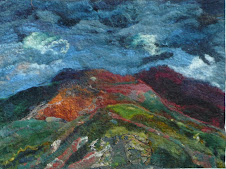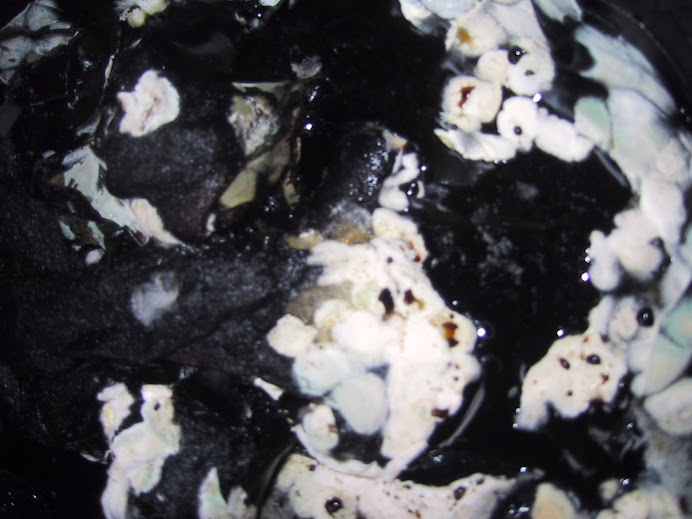Welcome to Sarah and Twisted Sister as new followers of the blog. It is nice to know you are enjoying the blog but please do leave comments-they make my day. :)


This is both about growing colour quite literally as plants in my garden and also about using them. I dye fibres with natural dyes and use them to "paint" with. This is how I make my landscapes , mostly of the North Wales countryside Mae Tyfu Lliw yn enw addas iawn i'r 'blog' yma. Yr wyf yn cael hwyl yn tyfu bob math o flodau i Helen i'w defnyddio. Mae hi yn creu lluniau bendigedig, mae y lliwiau yn hollol naturiol, ac felly'n gweithio'n dda iawn yn rhoi lliw credadwy o'r wlad o'm cwmpas







As a child my mother took me to see the Vermeers ( we lived in the Hague then), the Impressionists in Paris when I was 12 and Turner on the return to the UK. It is only very recently that it dawned on me that I responded to all these with an inner excitement I did not recognize at the time because of the light and how it falls.
As I have surfed the blogging world I have loved the blogs which show landscapes as well as art work as this shows the light that the blogger are living in ( if that makes sense). This is particularly true of the Australian blogs such as herewitht or India Flint's blog as the light is so different to the light here but also recently Leigh in the USA showed the autumnal trees near her. How much do people think the light and the colours around them effect their work either consciously or unconsciously?
Well here are some pictures taken to day and in the space of a half hour morning walk ( about 9am) with the dog . You can see from at least one why I wanted blue and bronze inks!
Welcome to new followers of my blog Patrica, FontaineFleurie and PepperJulies who have joined in since my last post. It is great to having you all here, keeps me on my mettle and it has definitely increased links as I always look at the blogs and often the other blogs a follower follows.
I am busy getting ready for 21/2 days of workshops at the Harbour Gallery Jersey next weekend. This is the first time I had to go by air to a workshop destination. As I dye all the fibers and make up packs for all my workshops this has been an interesting exercise. Two boxes with the packs for the main workshop went off last week now I am packing a large suitcase with more packs, extras and a small shop. I am hoping that I can get most my clothes into my quite capacious overnight bag which will go in the overhead locker in the aircraft. Enys, who always travels light says you just need one change of clothes and enough knickers to last! I am not sure I can travel quite that light but I definitely will have to restrain myself from slinging in extra pairs of shoes just in case and one or two extra sweaters.







The merino's below have been dyed in golden rod overdyed with indigo, golden rods, green extract, madder, logwood, cochineal and cochineal /madder exhaust








 I probably dyed about 100-150g of fibres but I will check tomorrow when they are dry. I have not obviously done light fastness tests yet but according to John and Margaret Cannon -Dye Plants and Dyeing published by Kew Garden, cosmos sulphurous (my cosmos is in the same genus), is in the same dye group as coreopsis tinctoria and dahlia. Originally they came from Mexico and were used by the Aztecs before the Spanish invaded Central America. I first grew these plants because my mother in the last few years of her life grew them and they reminded me of her. Enys and I think I brought a packet of seeds and handed them to her but we both have been very pleased with them. They obviously have enjoyed the wet summer which is surprising as my mother lived in dry Surrey but they have been fantastic this year. So another dye plant which , like dyers chamonile, coreopsis tinctoria , lythrum salicaria and to a lesser degree genista tinctoria, is both beautiful and useful. The picked plants are already flowering again so will no doubt go in giving pleasure till the frosts come.
I probably dyed about 100-150g of fibres but I will check tomorrow when they are dry. I have not obviously done light fastness tests yet but according to John and Margaret Cannon -Dye Plants and Dyeing published by Kew Garden, cosmos sulphurous (my cosmos is in the same genus), is in the same dye group as coreopsis tinctoria and dahlia. Originally they came from Mexico and were used by the Aztecs before the Spanish invaded Central America. I first grew these plants because my mother in the last few years of her life grew them and they reminded me of her. Enys and I think I brought a packet of seeds and handed them to her but we both have been very pleased with them. They obviously have enjoyed the wet summer which is surprising as my mother lived in dry Surrey but they have been fantastic this year. So another dye plant which , like dyers chamonile, coreopsis tinctoria , lythrum salicaria and to a lesser degree genista tinctoria, is both beautiful and useful. The picked plants are already flowering again so will no doubt go in giving pleasure till the frosts come.


